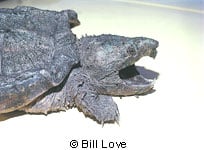Description:
The alligator snapping turtle has a grotesque appearance, with its roughened mud-brown carapace, grossly oversized head, hooked jaws and roughened tail nearly the length of the carapace. In captivity, the alligator snapper does not require a land area if their water is of suitable depth and temperature. Room temperature water (76 to 82 degrees Fahrenheit) is suitable. The water should be shallow enough to allow the alligator snapping turtle to breath when its neck is extended. High water quality should always be maintained; care should be taken to remove chlorine and chloramine additives whenever the water is changed. The ammonia content and pH of the water should also be checked frequently. The diets of hatchling captives seem to center largely on fish. In the wild, adult alligator snappers are known to eat shellfish, crayfish, snails, worms, insects, fish, amphibians and even some aquatic plants. Adult captives readily eat all of these things, plus snakes and raw meat of many kinds.
Habitat:
Aquatic. Rivers, streams and lakes.
Range:
Primarily along the Mississippi River in the mid- to southwest United States.
Scientific Name: Macroclemys temminckii
Species Group: turtle
Family: Chelydridae
Size: One of the largest species of freshwater turtles found in the world. Adult males weighing over 150 pounds with carapace lengths more than 25 inches are well-documented.
Level: advanced
Weight: N/A
Dangerous: No


